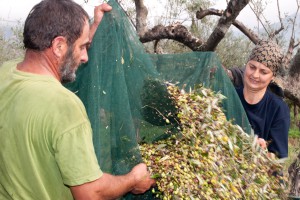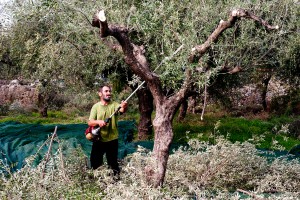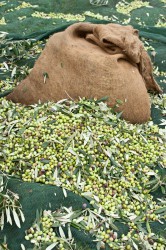The olive harvest in the Mani
9.03.20152014 will be remembered as one of the most difficult years for European olive production. Spain, the world’s largest olive oil producer, complains massive crop failures and is well below the normal annual production. Italy reports a reduction up to 50%. The causes are the weather conditions in 2014 and the olive fly that benefits from these conditions. In Greece, only the north was affected. In Peloponnese – and especially in the Mani – we had a slightly below-average quantity, but the quality of the crop is outstanding.
 The olive harvest in Mani begins in late November when the summer visitors begin their way home, and lasts until the end of January / beginning of February. In these months the region is in a state of vibrant activity.
The olive harvest in Mani begins in late November when the summer visitors begin their way home, and lasts until the end of January / beginning of February. In these months the region is in a state of vibrant activity.
Modern harvesting methods, as are usual in Spain and many parts of Italy, do not work here in southern Greece. Powerful harvesting equipment like the machines that shake the whole tree or those that ‘swallow’ it cannot be used in the Mani, as most Koroneiki trees are simply too old, too gnarled and deeply rooted. In addition, the slopes are so steep from about 600 meters altitude to sea level and the paths so stony that the use of large agricultural vehicles is unthinkable. Here, the harvested olives are taken to the mill on small tractors, carts, or even donkeys! To pick the olives from the trees, gentle and labor-intensive methods are applied.
 Large and small nets are placed under the olive trees, and the olives are hand-picked from the branches. This method is indeed the gentlest possible, but very time-consuming. Some elementary harvest aids employed can be long bamboo sticks, rakes and small portable machines with spinning rubber ‘fingers’ that shake the olives from the branches.
Large and small nets are placed under the olive trees, and the olives are hand-picked from the branches. This method is indeed the gentlest possible, but very time-consuming. Some elementary harvest aids employed can be long bamboo sticks, rakes and small portable machines with spinning rubber ‘fingers’ that shake the olives from the branches.
 The fruits are collected in large nets, roughly cleared free of leaves and transported in jute sacks to the nearest mill. After harvest it is essential for the quality of the olive oil that the time between harvest and milling is a short as possible, that’s why in the Mani there are dozens oil mills that run around the clock during harvest season. After only a few hours from the moment the olives were separated by their tree, the bright green oil runs out of the mill. The air is filled with the all the scents typical of oil milling, evocative of all possible shades of ‘green’, from freshly cut grass to olive leaves to green apples.
The fruits are collected in large nets, roughly cleared free of leaves and transported in jute sacks to the nearest mill. After harvest it is essential for the quality of the olive oil that the time between harvest and milling is a short as possible, that’s why in the Mani there are dozens oil mills that run around the clock during harvest season. After only a few hours from the moment the olives were separated by their tree, the bright green oil runs out of the mill. The air is filled with the all the scents typical of oil milling, evocative of all possible shades of ‘green’, from freshly cut grass to olive leaves to green apples.
As regards olive oil, the growers of the Mani this year will play a significant role in limiting the consequences of the European olive oil crisis.
Photos by: Mani Bläuel / Jürgen Schmücking
